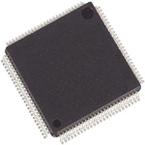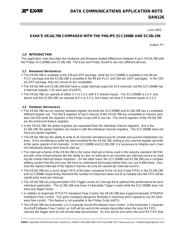下载

EXAR Corporation 48720 Kato Road, Fremont CA, 94538 • (510) 668-7000 • FAX (510) 668-7017 • www.exar.com • uarttechsupport@exar.com
DATA COMMUNICATIONS APPLICATION NOTE
DAN126
June 2002
EXAR’S XR16L788 COMPARED WITH THE PHILIPS SCC2698B AND SC28L198
Author: PY
1.0 INTRODUCTION
This application note describes the hardware and firmware-related differences between Exar’s XR16L788 with
the Philips SCC2698B and SC28L198. The Exar and Philips QUARTs are very different devices.
1.1 H
ARDWARE DIFFERENCES
• The XR16L788 is available in the 100-pin QFP package, while the SCC2698B is available in the 84-pin
PLCC package and the SC28L198 is available in the 84-pin PLCC and 100-pin LQFP packages. In the 100-
pin QFP package, they are not pin-to-pin compatible.
• The XR16L788 and SC28L198 both have a single interrupt output for all 8 channels, but the SCC2698B has
4 interrupt outputs; 1 for each pair of UARTs.
• The XR16L788 can operate at either 5 V or 3.3 V with 5 V tolerant inputs. The SCC2698B is a 5 V only
device and the SC28L198 can operate at 5 V or 3.3 V, but it does not have 5 V tolerant inputs at 3.3 V.
1.2 F
IRMWARE DIFFERENCES
• The XR16L788 has an industry standard register set while the SCC2698B and SC28L198 has a completely
different register set. The first 8 registers of each channel of the XR16L788 are compatible to industry stan-
dard 16C550 while the registers in the Philips Octal UARTs are not. The next 8 registers of the XR16L788
are the enhanced feature registers.
• In the XR16L788, the global registers are separated from the individual channel registers. But in the
SC28L198, the global registers are mixed in with the individual channel registers. The SCC2698B does not
have any global registers.
• The XR16L788 has the ability to write to all channels simultaneously for smaller and quicker initialization rou-
tines. Once simultaneous write has been enabled for the XR16L788, writing to any channel register will write
to the same register of all channels. In the SCC2698B and SC28L198, it is necessary to initialize each chan-
nel individually taking more time to start up.
• The interrupt scheme of the XR16L788 is the same interrupt scheme used in the industry standard 16C550
but with some enhancements like the ability to clear an interrupt in all channels per interrupt service by read-
ing the Global Interrupt Status Registers. On the other hand, the SCC2698B and SC28L198 use a complex
bidding system that the end user will have to understand thoroughly before they can use it effectively. Also,
only the highest interrupt of the highest channel can only be cleared per interrupt service.
• The XR16L788 has a much larger FIFO of 64 bytes compared to the 16 and 4 byte FIFOs in the SC28L198
and SCC2698B respectively, therefore the number of characters taken out of (or loaded into) the FIFO will be
significantly more per interrupt.
• The XR16L788 has programmable FIFO Trigger Levels of 1 through 64 to optimize the performance for each
individual application. The SC28L198 only have 4 Selectable Trigger Levels while the SCC2698B does not
have any trigger levels.
• In addition to Automatic RTS/CTS Hardware Flow Control, the XR16L788 also support Automatic DTR/DSR
Hardware Flow Control. This gives hardware designers flexibility in selecting which signals to use for hard-
ware flow control. This feature is not available in the Philips Octal UARTs.
• The XR16L788 has Automatic 1 or 2 character Xon/Xoff Software Flow Control. In the Automatic 1 character
Xon/Xoff Software Flow Control, an Xoff will be sent to the remote transmitter when the local RX FIFO
reaches the trigger level to halt remote data transmission. An Xon will be sent when the local RX FIFO falls




